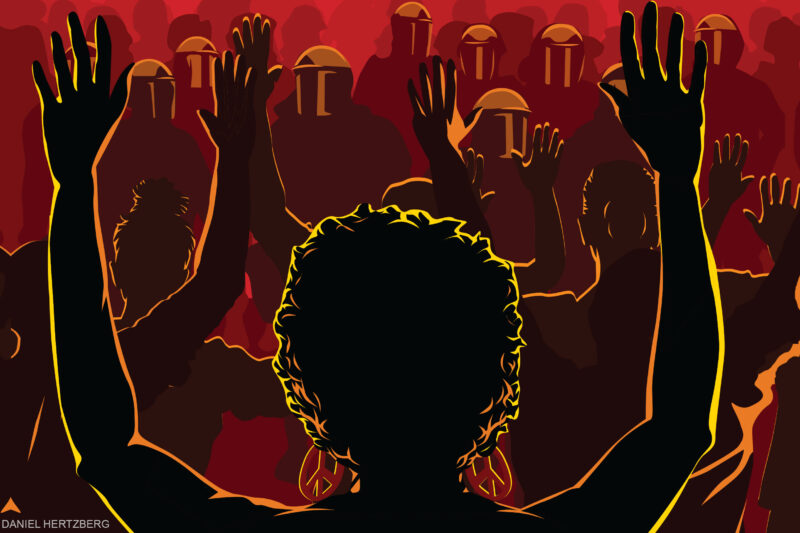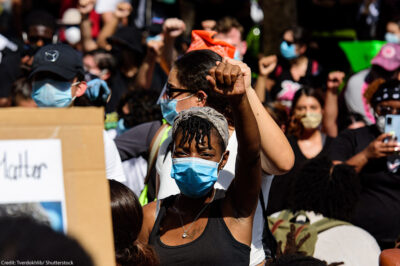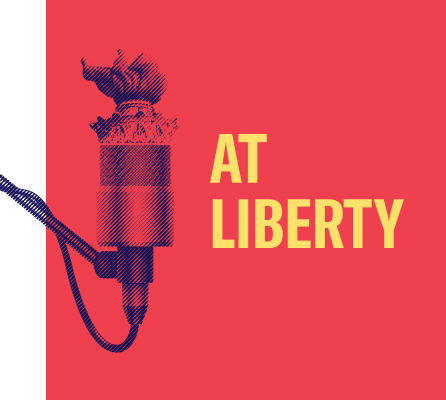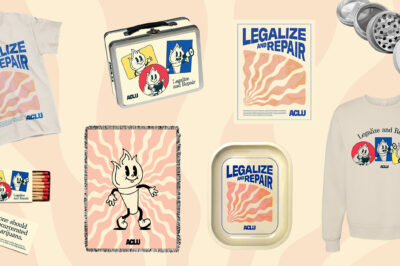
A version of this article originally appeared in STAND magazine, a publication for ACLU members and supporters.
THE POLICE SHOOTING AND KILLING of an unarmed Black teenager named Michael Brown on August 9, 2014, sparked civil unrest in his hometown of Ferguson, Missouri. The weeks that followed brought to a national audience shocking stories of inequity suffered by Ferguson residents at the hands of local law enforcement. The fundamental brokenness of the system seemed to be confirmed when a grand jury refused to indict the police officer who shot Brown. Meanwhile, to suppress public demonstrations, police equipped themselves like an occupying force, treating protestors as an insurgency to be stomped out.
The casual employment of tear gas, armored vehicles, and open antagonism by law enforcement are outgrowths of a system whose overaggression and empathy are, too often, inversely related. According to Ezekiel Edwards, director of the ACLU’s Criminal Law Reform Project:
“Ferguson is really the symptom of an illness that is quite serious and has really permeated many different police-community relationships around the country. While you can always see isolated incidents and think they’re just that — isolated — that would be a big mistake. The killings and the shootings that we have seen around the country are actually not particularly new. They’re getting a lot of media attention, but unarmed people — particularly people of color in poorer communities — bearing the brunt of excessive and sometimes fatal force on behalf of overaggressive police departments, often over transgressions or disputes that are quite minor, is a problem that we’ve had in this country for a very long time.”
This problem meshes with the complicated racial, social, and cultural history of the United States and was enshrined with the onset of the so-called war on drugs. In 1971, President Richard Nixon called drug abuse “public enemy number one,” and in prepared remarks declared, “In order to fight and defeat this enemy, it is necessary to wage a new, all-out offensive.” This prompted a shift in the way police operate, creating new funding streams that financially empowered law enforcement, jails, and prisons, focusing them in the local public-safety paradigm.
It’s the daily indignity of thousands of police encounters that degrades the relationships between communities and police.
“[Police] were going to operate more like paramilitary forces fighting a wartime enemy,” Edwards says, “and less like community-oriented, problem-solving, public-health-driven police departments looking to figure out how to work with the community and other stakeholders to help people who have drug addictions and people in poverty seeking improved schools and job opportunities and viable alternatives to the black market, and thinking of intelligent long-term responses to drug use and sale.”
Compounding these problems, federal and state policymakers passed draconian and often mandatory sentencing laws that severely punished people convicted of violating drug laws, resulting in long sentences that could span decades, including life-without-parole. These punitive, and ultimately ineffectual, incarceration efforts exacerbated the fraying relationships between police and their communities.
Meanwhile, many state and local law enforcement agencies, often as part of the performance metrics required when receiving federal funding, used simple arrest figures to measure the success of their drug enforcement efforts. The use of such metrics permeated the local culture of policing, resulting in internal performance goals that likewise focused heavily on high numbers of arrests, as opposed to measuring public safety, the number of arrests resulting in successful prosecutions, assessing community satisfaction with the police, and the state of community-police relationships, among others. This incentivized officers to prioritize arrests for low-level offenses, which are easy to make and easy to count.
According to Edwards, the problem intensified in the 1980s and 1990s, as poorly managed and largely unaccountable “task force” crime units were established to patrol city streets with a particular emphasis on drug law enforcement. The political response to the terrorist attacks in 2001 made things worse and provided justification, however specious and misplaced, for local police departments to build or expand SWAT teams and purchase surplus military hardware to carry out domestic law enforcement duties.

Many of these ill-considered policies have resulted not in increased trust, partnership, and respect between law enforcement and the residents of communities they are sworn to serve, but in increasingly adversarial relationships, with both sides resenting and fearing the other.
OVERLY AGGRESSIVE POLICING is often justified by police and politicians because of violence associated with the drug war or communities of color. Seema Sadanandan, policy and advocacy director for the ACLU of the Nation’s Capital in Washington, D.C., says the reality is much different.
For starters, assaults and felony killings of police officers in the United States are down sharply over the past two decades, she says. Furthermore, while the pattern of violence communities of color face from police is a real problem, “the vast majority of aggressive police encounters — particularly in Black and brown communities — do not result in someone getting shot and killed,” she says. Rather, “it’s the daily indignity of thousands of police encounters that degrades the relationships between communities and police and makes our communities less safe overall.” Consequently, it’s not simply a matter of taking tanks away from police.
Washington, Sadanandan says, is a perfect example of this. “D.C. is largely held up across the country as a model of so-called community policing,” she says, “and oftentimes when you hear about incidents like what happened in Ferguson or with Eric Garner in New York, it’s justified by citing black-on-black violence.” However, she adds, when you look at the actual policing of communities, the majority of policing is focused on the aggressive enforcement of low-level offenses. For example, in D.C., 96 percent of more than 45,000 arrests every year are for nonviolent offenses. “Yet when you question aggressive policing of black communities, oftentimes they use the justification of black-on-black violence,” she says.
Good policing is essential to strong and safe communities. The police are not our enemy — police abuse and brutality are.
This misrepresentation by hyperaggressive law enforcement and its tragic resonance with the wider public has shaped the way the ACLU approaches the issue and works for reform. The ACLU, Sadanandan says, “focuses on the way in which inequity is reproduced by institutions. So we’ve had to change and shift those systems, and that’s why we have to use so many different strategies. That’s why we have to use policy and advocacy and public education and litigation. We’re looking at system change.”
Part of such a change, according to Sadanandan, includes shattering the “war on drugs” rhetoric that has wrongly distorted public perceptions of crime and punishment. She explains:
“As a society we have centralized the use of the criminal justice system as our primary instrument for addressing social issues. A kid acts up in school? Call the police. You’re having an issue in your local community? Call the police. Young people are out on the corner smoking marijuana? Call the police. The criminal justice system is really a blunt instrument when it comes to dealing with all these social problems.
“This is the legacy of the war on drugs, which itself arose from the legacy of criminalizing and marginalizing Black and brown communities and immigrant communities. It has to do with structures from top to bottom, and it has to do with the values that have been strengthened through the war on drugs.”
Those values include punishment as a deterrent, and justice equals revenge. But when you thoughtfully explore these issues with victims of crime, you find most victims aren’t actually looking for revenge, Sadanandan says. In fact, the group of people who are most susceptible to victimization by violent crime in America is young black men — the same people who are being incarcerated.
“So the line between victim and so-called offender is very thin and gray, and more often than not the groups are made of the same people,” she says. “In our thinking about public safety, we need a shift to include people of color and the poor in our metrics about what strategies are making communities safer.”
The ACLU also seeks to ensure that the public doesn’t see the police as the enemy. As ACLU Executive Director Anthony Romero puts it, “Good policing is essential to strong and safe communities. The police are not our enemy — police abuse and brutality are. If we do our best to address police abuse, brutality, and impunity, we must also double down on our efforts to ensure that we not demonize all police and the essential role they play.”
In our thinking about public safety, we need a shift to include people of color and the poor in our metrics about what strategies are making communities safer.
IN THE GRIM SHADOW OF THE DRUG WAR, one area of promise in public safety is the adoption of body cameras, which attach to the uniforms of law enforcement officers and record encounters between police and the public. These devices help clarify events for internal review and legal proceedings. They are beneficial on both sides of the lens, providing an uneasy public with a new tool to hold police accountable while giving the police a way of showing when they have used force reasonably.
Dennis Parker, the director of the ACLU’s Racial Justice Program, considers police departments’ increasing acceptance of body cameras to be the first step.
“It is at least a reflection that more and more police departments are recognizing that there is a problem,” he says. “Whether or not that’s going to be the answer remains to be seen — there are studies that go both ways — but it’s at least an acknowledgment that there’s something wrong with too many police-civilian interactions.”
Along those lines, Parker says, police need to do a much better job of collecting and examining data and using it to determine when and where bias exists.
“They need to make clear that it is a priority that treatment has to be fair,” he says. “The use of force has to be fair and justified. And police should be held accountable, which is perhaps the biggest thing that’s missing now.”
There are signs of improvement. Alongside the adoption of body cameras are early attempts at improving training and data collection. Meanwhile, a number of police departments across the country are beginning to focus on ways in which they might mend the frayed bonds between themselves and the communities they are charged with protecting.
Parker is hopeful that such efforts will proliferate. “Improving relations between police and communities of color,” he says, “is a necessary step that is ultimately even more important than technological improvements like body cameras.” There is a long road ahead, and much work to be done.





